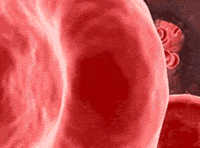
The animation above shows red blood cells moving through a small blood vessel. Their prime function is to transport oxygen to the body and so their structure is modified to suit this function. Red blood cells always remain within blood vessels unless the blood vessel is ruptured, through trauma or infection, in which case blood spills into the surrounding tissue. They have no nucleus and so the membrane is sunk on both sides giving the cells their unique biconcave disc shape. The sunken appearance allows for a greater surface area which is necessary for efficient exchange of gases.
These cells are about 8 micrometers in diameter and five million are present in one cubic millimetre. As the red blood cells get older there membranes weaken and tend to rupture as they travel through the small capillaries of the liver and spleen only to be mopped up by the white blood cells. They have a life span of approximately 120 days and are replaced at the rate of 1.5 million per second by the red bone marrow.
.
The lack of a nucleus gives more room to store an oxygen carrying protein called haemoglobin. Packed with this haemoglobin each red blood cell can carry an enormous amount of oxygen to the body. In the lungs, oxygen diffuses across the thin membrane of the red blood cell and attaches to haemoglobin. Four oxygen molecules attach to one molecule of haemoglobin and since each red blood cell contains, approximately, 250 million molecules of haemoglobin, 1 billion molecules of oxygen can be carried at any one time by a single cell.
The red blood cell has a unique donut shape. What is the advantage of this?
Where are red blood cells formed?
What is the function of the red blood cell?
Red blood cells are capable of
In which organ are old red blood cells removed?
What is the purpose of the nucleus? Why do red blood cells not have a nucleus?